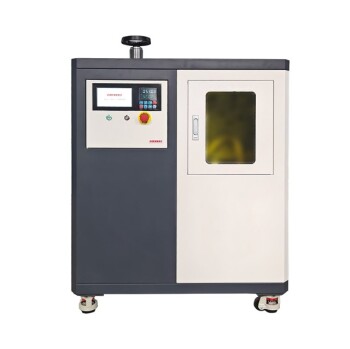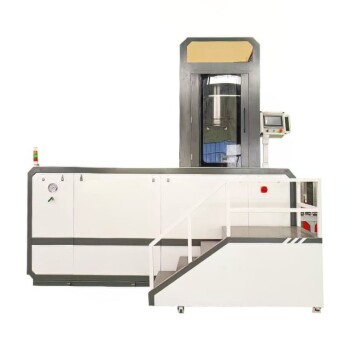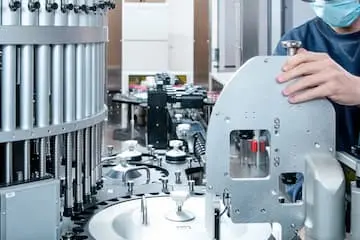Warm Isostatic Press (WIP) technology is a game-changer in the manufacturing industry, enabling uniform pressure application to shape and press powdered materials at precise temperatures. This advanced technology is ideal for creating complex parts and components with high precision. Our product range includes the Warm Isostatic Press (WIP) Workstation 300Mpa, perfect for shaping powdered products, and the Warm Isostatic Press for Solid State Battery Research, designed for semiconductor lamination and medical electronics. These presses are essential for industries requiring high-strength, stable, and precise material processing.
Toggle Categories
Get Instant Support
Choose your preferred way to connect with our team
-
Get Free Quote Fill out form for detailed pricing
-
Send Email Detailed inquiry support
-
WhatsApp Quick mobile chat
Response Time
Within 8 hours on working days, 24 hours on holidays
warm isostatic press

Warm Isostatic Press for Solid State Battery Research
Item Number : PCIH

Warm Isostatic Press WIP Workstation 300Mpa for High Pressure Applications
Item Number : PCIW
Why Choose Our Warm Isostatic Press (WIP) Solutions?
Warm Isostatic Pressing (WIP) is a cutting-edge technology that applies uniform pressure to powdered materials using liquid or gas mediums within high-pressure containers. This process is conducted at temperatures no higher than the standard boiling point of the liquid medium, ensuring precise control over the molding process.
Key Features of Warm Isostatic Press (WIP):
- Uniform Pressure Application: Achieve consistent pressure distribution across the material, resulting in high-quality, defect-free components.
- Precise Temperature Control: Our WIP systems offer a working temperature range of 0-240°C and ambient temperature operation between 10-35°C, ensuring optimal conditions for material processing.
- High-Pressure Capability: With a working static pressure range of 0-240MPa, our presses can handle a wide variety of materials, including those with special temperature requirements.
- Flexible Envelope Dies: Utilize flexible materials as envelope dies to form and press powder materials effectively.
- Heated Liquid Medium: The liquid medium is heated and continuously injected into the sealed pressing cylinder, ensuring accurate temperature control and efficient processing.
Applications of Warm Isostatic Press (WIP):
Our WIP solutions are widely used in industries requiring high-precision material processing, including:
- Semiconductor Manufacturing: Ideal for MLCC, hybrid chips, and medical electronics, enhancing strength and stability.
- Solid State Battery Research: Perfect for advanced research and development in battery technology.
- Powder Metallurgy: Essential for shaping powdered metals into complex parts with high precision.
- Medical Device Manufacturing: Used for creating high-strength, stable components for medical applications.
Advantages of Warm Isostatic Press (WIP):
- Enhanced Material Properties: Achieve superior material density and strength, resulting in high-performance components.
- Versatility: Suitable for a wide range of materials, including powders, binders, and other temperature-sensitive materials.
- Efficiency: Streamline the manufacturing process with precise temperature and pressure control, reducing production time and costs.
- Customizable Solutions: We offer tailored WIP systems to meet your specific manufacturing needs, ensuring optimal performance and results.
How It Works:
The Warm Isostatic Press process involves heating the liquid medium and injecting it into a sealed pressing cylinder through a booster source. The pressing cylinder is equipped with a heat generator to maintain precise temperature control. This process is ideal for materials that require special temperature conditions or cannot be formed at room temperature.
Ready to Transform Your Manufacturing Process?
Our Warm Isostatic Press (WIP) solutions are designed to meet the highest standards of precision and efficiency. Whether you're working on advanced semiconductor components, solid-state batteries, or high-strength medical devices, our WIP systems will help you achieve superior results.
Contact us today to learn more about our Warm Isostatic Press solutions and how we can customize them to meet your specific needs. Leave us a message to get started!
FAQ
What Is A Warm Isostatic Press?
What Are The Applications Of A Warm Isostatic Press?
What Is The Working Principle Of A Warm Isostatic Press?
What Are The Advantages Of Using A Warm Isostatic Press?
What Is The Operating Temperature Range Of A Warm Isostatic Press?
What Types Of Materials Can Be Processed Using A Warm Isostatic Press?
REQUEST A QUOTE
Our professional team will reply to you within one business day. Please feel free to contact us!
Related Articles

Why Your Lab Press Fails: It's Not the Tonnage, It's the Steel
Discover the hidden reason your hydraulic press gives inconsistent results. Learn why the choice of steel is more critical than tonnage for safety and accuracy.

The Invisible Geography of Heat: Why "Max Temperature" is a Trap
In thermal processing, maximum temperature is often a vanity metric. Discover why the "Uniform Heated Zone" is the true architect of repeatability.

Beyond the Spec Sheet: Matching Freeze Dryer Capabilities to Your Application's Critical Needs
Choose the right freeze dryer for pharma, food, or biotech. Key specs like cold trap temp, vacuum, and cooling rate impact drying speed and product quality.

Understanding Hot Isostatic Pressing in PVD Sputtering Targets
Explores the role of hot isostatic pressing in enhancing the quality and uniformity of PVD sputtering targets, focusing on manufacturing techniques and benefits.

Manufacturing Sputtering Targets Using Powder Metallurgy
Detailed process and applications of powder metallurgy in manufacturing sputtering targets.

Laboratory Water Bath Instructions for Use
Guidelines for operating and maintaining laboratory water baths for safe and effective use.

Hazards and Safety Precautions of Laboratory Pressure Vessels
An overview of the dangers and safety measures for pressure vessels in laboratory settings.

Laboratory Safety: Safe Use of High Voltage Equipment
Guidelines for the safe operation of high-pressure equipment in laboratories, including reactors, hydrothermal reactors, autoclaves, and gas cylinders.

Energy-Saving Benefits of Vacuum Atmosphere Tube Furnaces
Exploring how vacuum atmosphere tube furnaces optimize energy use through design and operational techniques.

Chip Manufacturing: Comprehensive Guide to the Annealing Process
Detailed exploration of the annealing process in semiconductor fabrication, its types, key parameters, and applications.

Functions of a Vacuum Hot Press Sintering Furnace
Exploring the key functions of vacuum hot press sintering furnaces in material processing.

Understanding Hot Presses and Safety Considerations
An overview of hot presses, their applications, advantages, and safety precautions.

Advantages of Vacuum Sintering Furnace
Explores the benefits of vacuum sintering furnaces, focusing on reduced harmful components, improved material properties, and lower temperature requirements.

Guidelines for Safe Operation and Procedures of Flat-Plate Hot Press in Lamination Experiments
Detailed safety and operational guidelines for using a flat-plate hot press in lamination experiments, including pre-operation checks, material preparation, heating procedures, and post-processing.

Safety and Operational Guidelines for Flat-Plate Hot Press in Lamination Experiments
Detailed safety measures and operational steps for using a flat-plate hot press in lamination experiments.

Isostatic Pressing Technology: Principles, Classification, and Applications
An in-depth look at isostatic pressing technology, its types, and diverse applications across various industries.

Advanced Alumina Ceramics: Applications and Manufacturing Techniques
Overview of alumina ceramics' applications and manufacturing methods, including molds, isostatic pressing, and green body formation.

Zirconia Ceramic Rod Production Processes: Isostatic Pressing vs. Dry Pressing
A comparison of isostatic pressing and dry pressing in zirconia ceramic rod production, highlighting differences and advantages.

Choosing the Right Warm Isostatic Press: Key Factors to Consider
Guidelines for selecting a suitable warm isostatic press based on cavity size, pressure range, accuracy, temperature, capacity, ease of use, maintenance, and environmental restrictions.

Ceramic Isostatic Pressing Mold Technology
Exploring the design and factors affecting ceramic isostatic pressing molds.
